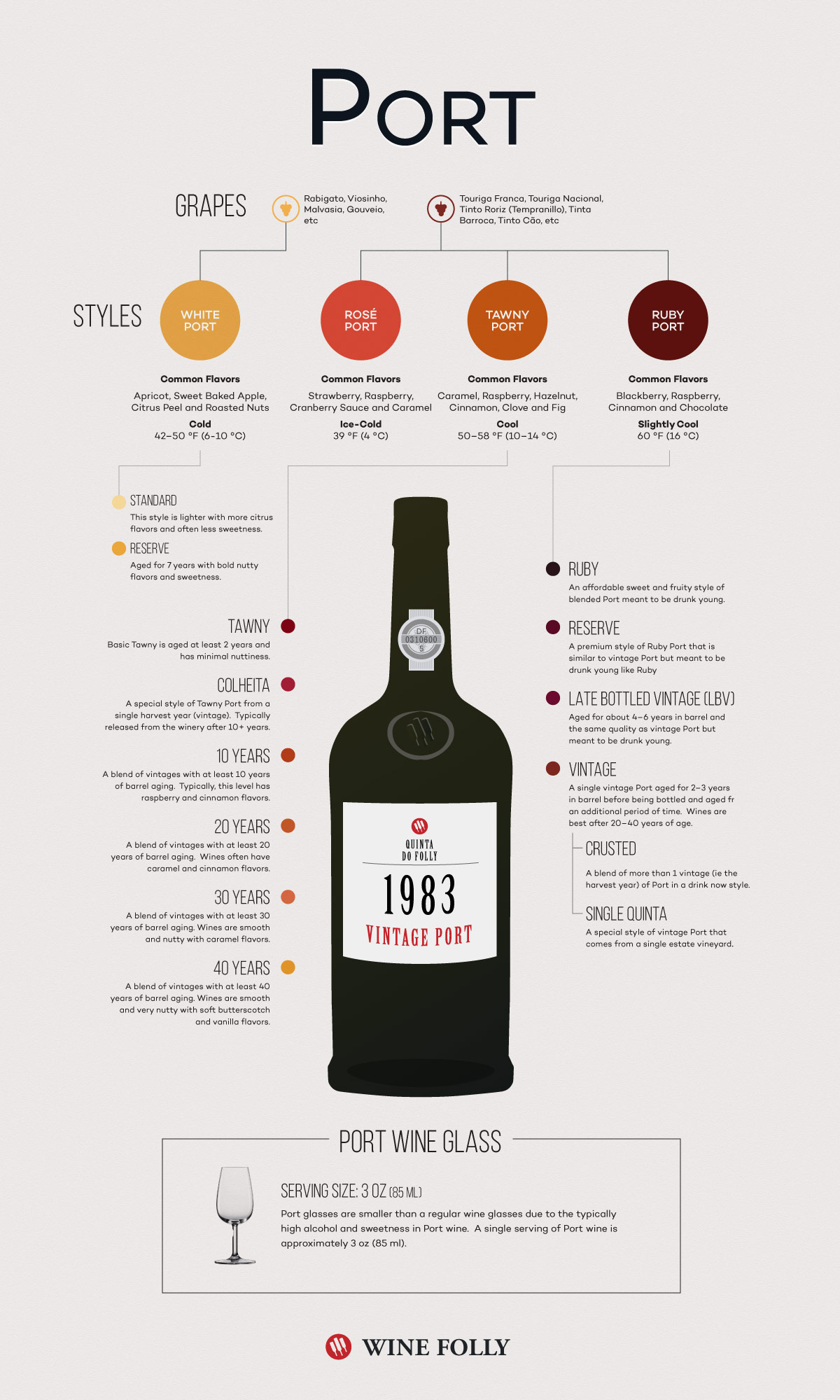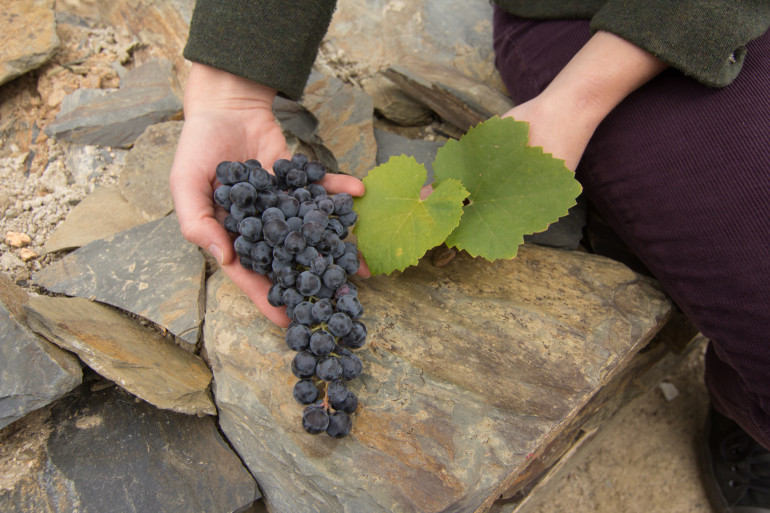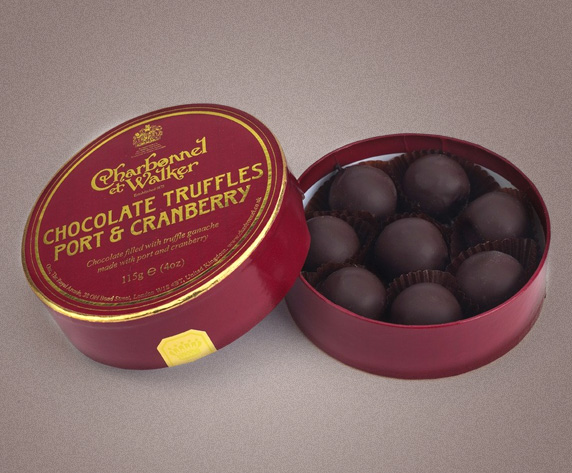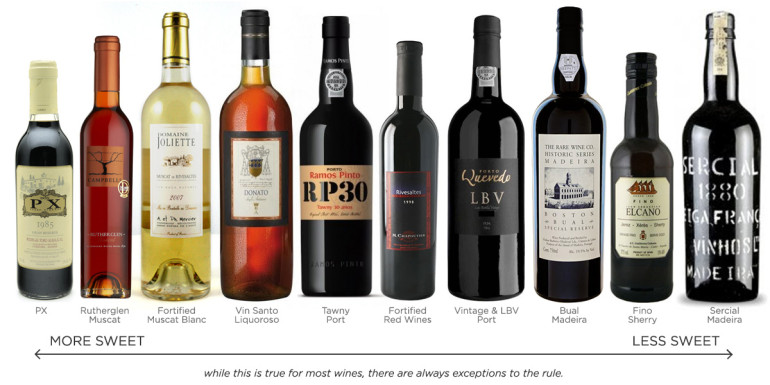Port is a sweet, red, fortified wine from Portugal.

Port wine is most commonly enjoyed as a dessert wine because its richness.
There are several styles of Port, including red, white, rosé, and an aged style called Tawny Port.
While much of the Port we see in the supermarket is of average quality, there are many fine Port wines that are highly treasured and cost several hundred dollars. Let’s get up to speed on this fascinating, historic sweet red wine.

What does Port Wine Taste Like?
Port is a sweet wine with flavors of raspberry, blackberry, caramel, cinnamon, and chocolate sauce. Sound delicious? It is!
There are several styles of port, but the 2 major styles of Port include a red Port with more berry and chocolate flavors (and slightly less sweetness), and a tawny-colored Port with more caramel and nut flavors (and more sweetness).
Older, fine Tawny Ports have an even wider array of subtle flavors including graphite, green peppercorn, hazelnut, almond, butterscotch, and graham cracker. Look for wines aged for 30 or more years for this level of complexity!

The Common Styles of Port Wine
There are many different official categories of Port, but most fall under these 4 categories:
- Ruby (Red) Port: a deeply-colored red Port which includes Vintage, Late-bottled Vintage (LBV), Crusted and Ruby Port
- Tawny Port: a very sweet barrel-aged port with oxidative nut and caramel flavors
- White Port: made with indigenous white grapes including Rabigato, Viosinho, Gouveio and Malvasia
- Rosé Port: This is a new style of Port wine made like rosé wine with flavors of strawberry, violets and caramel
Serving Port Wine
Port should be served just below room temperature, around 60 °F (16 °C). A popular way to serve Ruby Port in the summer (with a meal) is on the rocks with a peel of lime!
Pairing with Food
Port wine pairs wonderfully with richly flavored cheeses (including blue cheese and washed-rind cheeses), chocolate and caramel desserts, salted and smoked nuts, and even sweet-smoky meats (barbecue anyone?).

What Makes Port Unique?
One of the most important qualities of true Port is the unique blend of Portuguese indigenous grapes. Port grapes include Touriga Franca, Touriga Nacional, Tinta Roriz (aka Tempranillo), Tinta Barroca and Tinta Cão, and there are said to be at least 52 varieties! Each grape adds a unique flavor to the blend. For example, Touriga Nacional adds blueberry and vanilla notes, and Touriga Franca adds raspberry and cinnamon notes.

Grape stomping
Traditional Port ferments in lagars where people stomp grapes with their feet. Today, most Port wineries use automatic lagars with mechanical “feet” in place of manual labor. However, a few producers still follow the old way!
Special wine glass
A Port wine glass is smaller than a regular wine glass and the serving size is approximately 3 oz.

Port Wine and Cooking
Port is a popular addition to chocolate cakes, sweet gooey chocolate sauces, and it’s even used as a reduction sauce. Reductions are wonderful over savory dishes like steak (especially a blue cheese topped steak).
Chefs often simmer Port wine and reduce it to a thick sauce. Port reduction is used much like balsamic glaze.
Port is a flavorful alternative to brown sugar or maple syrup.
Which Port to Use in Cooking?
Most recipes call for the affordable Ruby Port. This style is red and will impart red berry and cinnamon-like flavors into your sauce. Remember, a true Portuguese Ruby Port may cost $10–$20 a bottle, but will last open for a long time.
Port Wine Substitute
In a pinch, you can use 2 parts dry bold red wine, 1 part alcohol (brandy or vodka), and about 1/4 part sugar. It won’t be ideal, but much better using red wine!

How long does Port last open?
A Ruby-style Port will stay fresh for about 2 weeks (a month if preserved properly in your fridge)
Tawny Port stays fresh for about a month. Keep wines longer by storing them in a cool dark place and using a vacuum preserver to remove oxygen.
How long will Port Cellar?
Vintage Port is designed to age a long, long time!
There are highly-prized Vintage Ports over 100 years old! However, most Port we see in the supermarket is bottled in a way that should be drunk upon purchase. You can tell which is which by looking at the cork.
A Vintage Port has a regular long cork, and the “drink now” style of Port has a plastic-topped cork cap.
Explore More Dessert Wines
Port is a dessert wine similar to Marsala and Madeira. Find out more about the different types of dessert wine.
